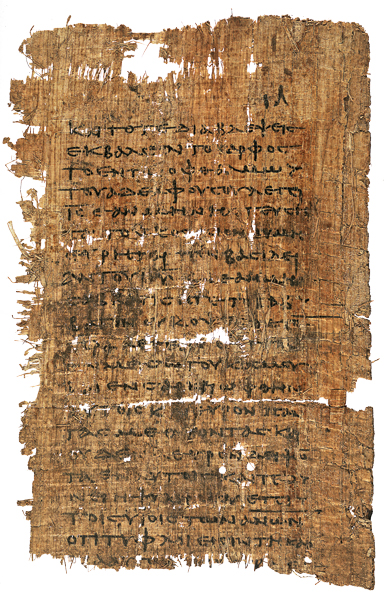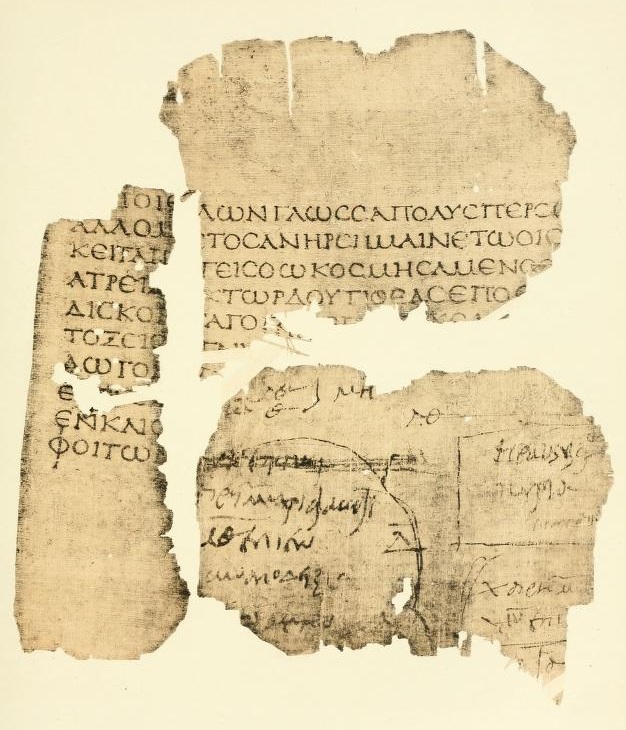|
Oxyrhynchus 840
The Oxyrhynchus Gospels are two fragmentary manuscripts discovered among the rich finds of discarded papyri at Oxyrhynchus in Egypt. They throw light on early non-canonical Gospel traditions. Oxyrhynchus 840 Oxyrhynchus 840 (P. Oxy. V 840), found in 1905, is a single small vellum parchment leaf with 45 lines of text written on both sides in a tiny neat hand that dates it to the 4th century, almost square, less than 10 cm across. It is kept at the Bodleian Library, MS. Gr. th. g. 11 (P). The text probably predates 200, but no more is determinable from this evidence. In his introduction in ''The Complete Gospels'', Philip Sellew notes that this fragment was likely a talisman text, kept as an amulet, perhaps worn around the neck. Michael J. Kruger, who did his PhD dissertation on this fragment, concludes that this could be not an amulet but a miniature codex. The text itself has been dated to the first half of the second century. Sellew calls it "similar to the New Testament go ... [...More Info...] [...Related Items...] OR: [Wikipedia] [Google] [Baidu] |
Manuscript
A manuscript (abbreviated MS for singular and MSS for plural) was, traditionally, any document written by hand or typewritten, as opposed to mechanically printed or reproduced in some indirect or automated way. More recently, the term has come to be understood to further include ''any'' written, typed, or word-processed copy of an author's work, as distinguished from the rendition as a printed version of the same. Before the arrival of prints, all documents and books were manuscripts. Manuscripts are not defined by their contents, which may combine writing with mathematical calculations, maps, music notation, explanatory figures, or illustrations. Terminology The word "manuscript" derives from the (from , hand and from , to write), and is first recorded in English in 1597. An earlier term in English that shares the meaning of a handwritten document is "hand-writ" (or "handwrit"), which is first attested around 1175 and is now rarely used. The study of the writing ( ... [...More Info...] [...Related Items...] OR: [Wikipedia] [Google] [Baidu] |
Papyrus
Papyrus ( ) is a material similar to thick paper that was used in ancient times as a writing surface. It was made from the pith of the papyrus plant, ''Cyperus papyrus'', a wetland sedge. ''Papyrus'' (plural: ''papyri'' or ''papyruses'') can also refer to a document written on sheets of such material, joined side by side and rolled up into a scroll, an early form of a book. Papyrus was first known to have been used in Egypt (at least as far back as the First Dynasty of Egypt, First Dynasty), as the papyrus plant was once abundant across the Nile Delta. It was also used History of the Mediterranean, throughout the Mediterranean region. Apart from writing material, ancient Egyptians employed papyrus in the construction of other Artifact (archaeology), artifacts, such as reed boats, mats, rope, sandals, and baskets. History Papyrus was first manufactured in Egypt as far back as the third millennium BCE.H. Idris Bell and T.C. Skeat, 1935"Papyrus and its uses"(British Museum pam ... [...More Info...] [...Related Items...] OR: [Wikipedia] [Google] [Baidu] |
Oxyrhynchus Papyri
The Oxyrhynchus Papyri are a group of manuscripts discovered during the late nineteenth and early twentieth centuries by papyrology, papyrologists Bernard Pyne Grenfell and Arthur Surridge Hunt at an ancient Landfill, rubbish dump near Oxyrhynchus in Egypt (, modern ''el-Bahnasa''). The manuscripts date from the time of the Ptolemaic Kingdom, Ptolemaic (3rd century BC) and Roman Empire, Roman periods of Egyptian history (from Final War of the Roman Republic, 32 BC to the Muslim conquest of Egypt in 640 AD). Only an estimated 10% are literary in nature. Most of the papyri found seem to consist mainly of public and private documents: codes, edicts, civil registration, registers, official correspondence, census-returns, tax-assessments, petitions, court of record, court-records, sales, leases, last will and testament, wills, bill (law), bills, Account (bookkeeping), accounts, inventories, horoscopes, and private letters. Although most of the papyri were written in Greek language, ... [...More Info...] [...Related Items...] OR: [Wikipedia] [Google] [Baidu] |
Agrapha Of Jesus And Apocryphal Fragments
Agrapha (; Greek for "non written"; singular ) are sayings of Jesus that are not found in the canonical Gospels. The term was used for the first time by J.G. Körner, a German Bible scholar, in 1776. Definition of agrapha According to A. J. Maas, supposed agrapha must satisfy three conditions: * They must be sayings, not discourses – works like the "Didascalia" and the "Pistis Sophia", that speak of Jesus, but do not quote him, are not considered agrapha * They must be sayings of Jesus – agrapha are not sayings found in religious romances such as those found in apocryphal Gospels, the apocryphal Acts, or the Letter of Christ to Abgar, etc. * They must not be in the canonical Gospel, Gospels Mere additions to pre-existing sayings are not considered agrapha. Examples According to A. J. Maas, for agrapha to be genuine, they must be supported by external and internal evidence. This means that early writers, like Papias of Hierapolis, Papias, Clement of Alexandria, Clement, Ir ... [...More Info...] [...Related Items...] OR: [Wikipedia] [Google] [Baidu] |
Papyrus Oxyrhynchus 5575
Papyrus Oxyrhynchus 5575 (abbreviated as P. Oxy. 5575) is a second century papyrus fragment of multiple Gospels: Matthew, Luke, and Thomas. It is the oldest extant fragment from the Gospel of Thomas and comes from the era of Early Christianity before the formation of the New Testament. The papyrus fragment was published by the Egypt Exploration Society on August 31, 2023, after over a decade of study. Contents The first letters on the recto side may be part of Thomas 63:1–3 (similar to Luke 12:16–21). This is followed by a saying similar to Luke 12:22/Matt 6:25a (lines 1–5). Next is a saying similar to Thomas 27 (lines 6–10), and text similar to Luke 12:24/Matt 6:25b–26 (lines 11–14). See also * Oxyrhynchus Papyri * Gospel of Thomas The Gospel of Thomas (also known as the Coptic Gospel of Thomas) is a non-canonical Logia, sayings gospel. It was discovered near Nag Hammadi, Egypt, in 1945 among a group of books known as the Nag Hammadi library. Scholars specula ... [...More Info...] [...Related Items...] OR: [Wikipedia] [Google] [Baidu] |
Papyrus Oxyrhynchus 210
Papyrus Oxyrhynchus 210 (P. Oxy. 210 or P. Oxy. II 210) is an early Christian fragment, written in Greek. It was discovered in Oxyrhynchus. The manuscript was written on papyrus in the form of a codex. It is dated to the third century. Currently it is housed in the Cambridge University Library (4048) in Cambridge.P. Oxy. 210 at the Oxyrhynchus Online Description The document was written by an unknown author. The measurements of the fragment are 173 by 85 mm. The text is related to Matthew 7:17-19 and |
Papyrus Oxyrhynchus 1
Papyrus Oxyrhynchus 1 (P. Oxy. 1) is a papyrus fragment of the logia of Jesus written in Greek (''Logia Iesou''). It was among the first of the Oxyrhynchus Papyri discovered by Grenfell and Hunt. It was discovered on the second day of excavation, 12 January 1897, in the garbage mounds in the Egyptian town of Oxyrhynchus. The fragment is dated to the early half of the 3rd century. Grenfell and Hunt originally dated the fragment between 150 and 300, but "probably not written much later than the year 200." It was later discovered to be the oldest manuscript of the Gospel of Thomas. __NOTOC__ Description The manuscript was written on papyrus in codex form. The measurements of the original leaf were . The text is written in uncial letters, with one column per page and 21 lines per page, in a reformed documentary hand.Larry Hurtado, ''The Earliest Christian Artifacts'' (Wm. Eerdmans 2006), p. 228. The last line is fragmented. There is a pagination at the upper right corner (number Ι� ... [...More Info...] [...Related Items...] OR: [Wikipedia] [Google] [Baidu] |
Oxyrhynchus Papyri
The Oxyrhynchus Papyri are a group of manuscripts discovered during the late nineteenth and early twentieth centuries by papyrology, papyrologists Bernard Pyne Grenfell and Arthur Surridge Hunt at an ancient Landfill, rubbish dump near Oxyrhynchus in Egypt (, modern ''el-Bahnasa''). The manuscripts date from the time of the Ptolemaic Kingdom, Ptolemaic (3rd century BC) and Roman Empire, Roman periods of Egyptian history (from Final War of the Roman Republic, 32 BC to the Muslim conquest of Egypt in 640 AD). Only an estimated 10% are literary in nature. Most of the papyri found seem to consist mainly of public and private documents: codes, edicts, civil registration, registers, official correspondence, census-returns, tax-assessments, petitions, court of record, court-records, sales, leases, last will and testament, wills, bill (law), bills, Account (bookkeeping), accounts, inventories, horoscopes, and private letters. Although most of the papyri were written in Greek language, ... [...More Info...] [...Related Items...] OR: [Wikipedia] [Google] [Baidu] |
Gospel Of Thomas
The Gospel of Thomas (also known as the Coptic Gospel of Thomas) is a non-canonical Logia, sayings gospel. It was discovered near Nag Hammadi, Egypt, in 1945 among a group of books known as the Nag Hammadi library. Scholars speculate the works were buried in response to a letter from Bishop Athanasius of Alexandria, Athanasius declaring a strict canon of Christian scripture. Most scholars place the composition during the second century, while some have proposed dates as late as 250 AD and others have traced its signs of origins back to 60 AD. Some scholars have seen it as evidence of the existence of a "Q source" that might have been similar in its form as a collection of sayings of Jesus, without any accounts of his deeds or his life and death, referred to as a sayings gospel, though most conclude that Thomas depends on or harmonizes the Synoptics. The Coptic language, Coptic-language text, the second of seven contained in what scholars have designated as Nag Hammadi ... [...More Info...] [...Related Items...] OR: [Wikipedia] [Google] [Baidu] |
Q Document
The Q source (also called The Sayings Gospel, Q Gospel, Q document(s), or Q; from , meaning "source") is a hypothesized written collection of primarily Jesus' sayings (, ). Q is part of the common material found in the Gospels of Matthew and Luke but not in the Gospel of Mark. According to this hypothesis, this material was drawn from the early Church's oral gospel traditions. Along with Marcan priority, Q had been hypothesized by 1900, and remains one of the foundations of most modern gospel scholarship. Funk, Robert W., Roy W. Hoover, and the Jesus Seminar. ''The Five Gospels.'' HarperSanFrancisco. 1993. "Introduction," pp. 1–30. B. H. Streeter formulated a widely accepted view of Q: that it was written in Koine Greek; that most of its contents appear in Matthew, in Luke, or in both; and that Luke better preserves the text's original order than does Matthew. In the two-source hypothesis, the three-source hypothesis and the Q+/Papias hypothesis, Matthew and Luke both ... [...More Info...] [...Related Items...] OR: [Wikipedia] [Google] [Baidu] |






